Meghan Matt, a sophomore international business major from Mound, Minnesota, will study abroad in Panama from December 27 to January 7. Matt chose to apply for the Sustainable Entrepreneurship in Panama program because she wanted to experience Latin American business culture. Leading up to their time in Panama, students develop a marketing plan for a Panamanian teakwood farmer and will work to implement it during their trip. She said, “I am most looking forward to meeting the local farmer who we have been writing a marketing plan for in class.” As one of the college’s Distinguished International Business Scholars, she also plans to get an internship in China and spend a semester in Denmark while pursuing her degree at Nebraska.
Reflections - 1/10/18
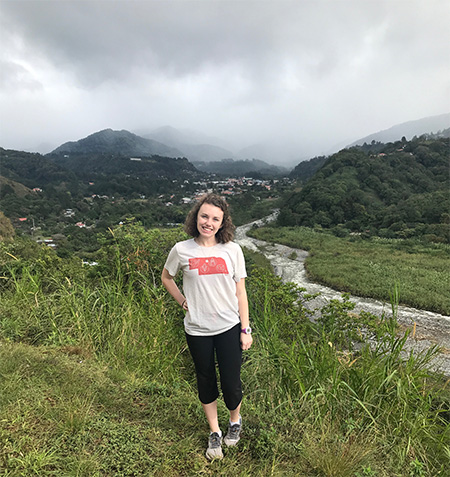 The world is my oyster.
The world is my oyster.
I have been home from Panama for a few days now. I have had time to reflect on my trip, look through all my pictures and share my adventures with friends and family. Overall, I am extremely grateful to have had such an amazing opportunity. Before I sign off of my blog, I have a few final words.
On Saturday, we finally presented our semester-long marketing plan to the Rios family. There were two presentations, the East and West coast groups. Both teams presented exceptionally well. Mr. Rios even told us he learned things about teakwood that he did not know before. Imagine that! A group of business students taught something about teakwood to a specialist in the subject AND the owner of a teakwood farm. It was such a great experience. And for those of you wondering, my group, the West coast, won the overall competition. We were rewarded with Panamanian baseball hats.
I compiled a list of some of the things I learned during my two weeks abroad (If you have not noticed by reading my blogs, I love making lists). They are just some general takeaways and random thoughts.
-
The timing and scheduling in Panama are much more relaxed. Things typically begin 30 minutes after they are planned to start. Meetings and presentations run long.
-
Everybody dances! They dance recreationally and are all good at it. I want to take a salsa dancing class now.
-
Panama City is extremely modern and built up, yet there are still parts that lack running water and development.
-
The people age well. Nobody looks old because their skin barely wrinkles and they have the energy of a twenty-year-old still.
-
The fruit is so fresh! I ate the best pineapple in my life every morning for breakfast.
-
Eggs are not refrigerated. I found this to be a little odd. In all the grocery stores, the egg cartons are simply sitting on a room temperature shelf.
-
Most of the cars are Hondas and Toyotas. You did not see many American made cars like Ford and Chevy.
-
There are a lot of stray dogs. They are in the city, the rural areas and the suburbs. It was difficult to resist giving them a hug and a kiss.
-
The landscape is so green and the air is really fresh.
-
Panamanians are proud to be Panamanian.
I will end my blog with what I think is the best advice anybody can receive: travel the world! It is so important to immerse yourself in cultures that are different from what you are used to. I could add to my list and tell you a million more ways life in Panama is different than life in the Midwest, but that does not mean one lifestyle is more correct than the other. I think that if more people understood this, the world would be a much better place. If you are a student, consider studying abroad. I will be spending this summer in China for three months and the fall semester in Denmark. Even if you do not want to commit to such a long trip, sign up for a shorter one like this program in Panama.
Moments I Will Always Remember - 1/5/18
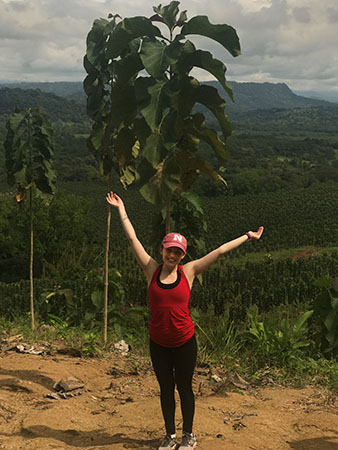 Teakwood overlook at Batipa.
Teakwood overlook at Batipa.
The past few days in David have been a dream! I hiked through the rainforest for my first time at Batipa. A big group of us went on the 4.75-mile hike and bonded over monkey sightings, dodging fire ants and good conversation. Throughout our trek, we would come across scenic overviews that looked down upon some of the teak farmland. It was cool to see where the product we have been marketing and researching all semester grew. We ended the workout with a delicious chicken, rice and salad lunch in front of the ocean.
We also went back to the University, OTEIMA, and split into our two West and East coast teams and added four Panamanian students on each team as well. We were instructed to create a tourism package we will present to the university and the owners of Batipa, Elena and Luis, on Saturday. The couple asked us to do this because they realize the value of tourism in Panama and their property at Batipa. Our ideas take the form of four different types of tourism: ethno-tourism, ecotourism, sports tourism and academic tourism.
We had plans to go on a group boat ride on Friday night, but it got canceled due to thunderstorms. Fortunately, this gave us the opportunity to discover and try an authentic gelato store with over 50 flavors of this sweet treat. The cone only cost $2.50, which was a pleasant surprise because it would have cost over $5 in the United States. Bargain! The group ate dinner at a local taco restaurant and then found their way to a bar where we played pool and ping pong.
Today we woke up and drove to Boquete, a village in the middle of a beautiful valley, overlooking a river and rainforests. The view was jaw-dropping. Boquete is one of the top places in Panama that U.S. citizens come to retire. After we walked around the town, we got back on the bus and drove to the town of Volcan for lunch. One of our tour guides, Abraham, grew up in the mountains of inactive volcanoes. He graciously invited our group to his childhood home for homemade chicken soup, volleyball and good company. His brother had a two-month-old rottweiler puppy named Rocky, who I followed around the entire afternoon. It was such a happy afternoon.
Arrival in David City - 1/2/18
 Presentation at OTEIMA
Presentation at OTEIMA
The first two days in our new city, David, have been great. We left early on New Year’s Day to start our six-hour bus ride to David. The town is in the Chiriquí province, just south of Costa Rica. I knew I loved David when I saw three giant iguanas at the park across from our hotel.
Today we ate breakfast at the hotel and then walked a few blocks to the Universidad Technológica OTEIMA, the university we will be working with during the remainder of the trip. Our local tour guide in David, Edmundo, is a professor at this school. We went to a lecture hall where we met six local students and watched a presentation about the university’s history. The presentation was led by the university’s principal, Elena Gnaegi and her husband, Luis Ríos. In addition to founding the university, the couple also own the teakwood farm, Batipa, that we have been writing a marketing plan for all semester.
The success this couple has made for themselves in their lives and during their 49 years of marriage is admirable. The business advice they gave was valuable. Elena told us the importance of working for other people and gaining a wide variety of experience before starting your own business. She advised us to invest in savings because times get tough and you do not want to rely on bank loans your whole life. Lastly, Elena stressed the importance of knowing a second language. She made the point that if she were not able to speak English, she would not be able to communicate with us during the presentation.
After sharing lunch with some of the students at OTEIMA, we all got on the bus and drove to Batipa. Although the teak farm is a part of Batipa, the land is also home to cattle, horses, sheep, birds, reptiles and monkeys. Batipa also has lakeshore on the coast of the Pacific Ocean. We spent our afternoon horseback riding, kayaking and taking in the beautiful rainforest surroundings. I obsessively watched for monkeys and was happy when I finally saw one swinging high in the trees on our way out of Batipa.
The Panama Canal - 12/31/17
Yesterday morning we started our day with the Panama Canal. Surprisingly, the City of Knowledge was only a five-minute drive away from the part of the canal that we visited, the Miraflores Locks. We were lucky to get there in time to watch the only cruise ship scheduled for that day go through the canal. We also got to tour the four-story museum exhibiting information, history and interactive parts.
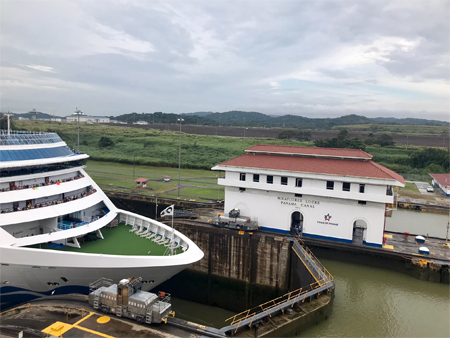 Cruise waiting for the second lock to fill with water.
Cruise waiting for the second lock to fill with water.
The canal has been my favorite part of the trip so far. I loved imagining it getting engineered and created over one hundred years ago. I enjoyed watching the three different locks fill up with water, opening when the water was level, then letting the ship through. Most of all I loved waving to all the passengers aboard the cruise ship. Some held signs saying Happy New Year.
Some fun facts about the Panama Canal:
1. The average ship pays $100,000 to travel through the Panama Canal. Cruise ships average around $400,000 to go through. Cargo ships carrying oil can cost as high as $850,000.
2. Around 50 ships cross the Panama Canal every day. Annually, about 12,000 to 15,000 ships go through.
3. It takes about eight to ten hours to get through the entire canal.
I would highly suggest either a Panama Canal cruise or a trip to the Miraflores Locks during your lifetime. This engineering marvel is beautifully made, and anybody can appreciate it. I am so happy I got the opportunity to yesterday!
Tour of Panama City - 12/29/17
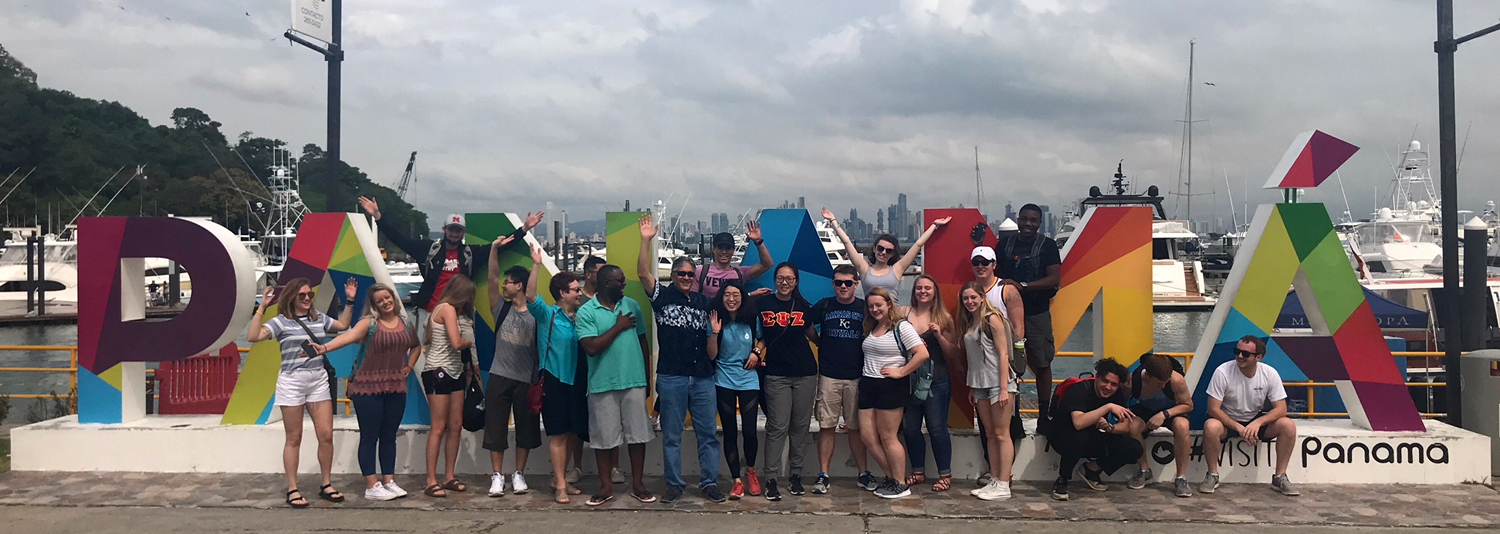 Group in front of Panama sign.
Group in front of Panama sign.
Everybody has been up and going by 8 a.m. on this trip so far. We started our morning with a presentation about Panama from a Nebraska alumnus named Jaime, who is a Panamanian. He took us on a bus tour around Panama City. He was informative. I learned and saw many parts of Panama City that I would otherwise not have experienced. One of the biggest things he talked about was the contrasts found within the city. There are billionaires in penthouse apartments living next door to slums without running water. It was crazy to see.
Jaime left us for lunchtime, and the group found its way to the Panama City Fish Market. We ate as a group at a local seafood restaurant right on the peer. I had fried shrimp, clams, french fries and ceviche. Yum! As some of us began to finish our meals, we somehow found our way to the front of the restaurant, where we created a dance party. We did the salsa to Latin music and made quite the scene. Locals were recording us on their cell phones. It was genuinely pure bliss.
Following our exciting lunch, Moises took us to “Casco Viejo” translated to “Old Town.” It is a neighborhood full of colorful buildings, paved brick streets, and classy restaurants and shops. We visited the Golden Altar at the Church of San Jose. The alter is the most massive piece of gold in the world.
We had a group dinner at an Italian restaurant. I have noticed how much more relaxed the Panamanian culture is than in the United States. Service is much slower. It took about three hours to eat dinner. They also bring out the meals for people as they are done, instead of bringing everybody’s food out at once.
Chagres National Park - 12/28/17
This morning our group woke up early to start our first full day in Panama. While we were waiting outside for the bus, Dr. Ibrayeva led us in yoga stretches. Although I am the most inflexible person you have probably ever met, the exercises were a great way to begin the day.
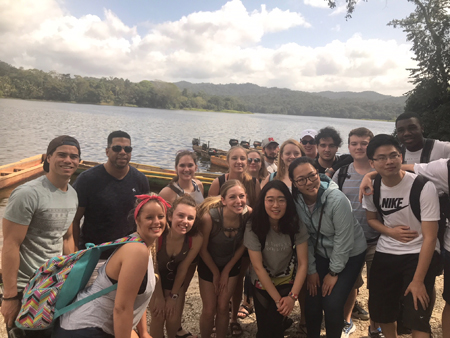 Students in front of the canoes.
Students in front of the canoes.
The bus took us to our destination: Chagres National Park. It was about 90 minutes away from the City of Knowledge, at the end of many winding and unpaved roads. As soon as we got there, we loaded two motorized canoes and were taken on a 20-minute ride to the native Embera Village. The Embera community is located on a remote island on the Chagres River. The community consists of about 25 different families and totals 120 people. The second our canoe pulled up onto their land, they welcomed us with not only open arms but with drums and music.
The community uses the clean water of the Chagres River to bathe, and they invited us to swim in it as well. The group had so much fun relaxing in the current, feeling the warmth of the sun on the beach, and being around one another. Some of the children from the community came and joined us. It was amazing to see how accustomed they were to be walking barefoot on the sharp rocks and hot sand.
After drying off, we were taken up the hill to their village. The community performed a native dance and song for us and then invited us to join them. All of the men came up to the girls in our group and asked us to dance with them. It amazed me how happy everybody was. It’s like they all live without a care in the world. I think everybody should experience something like that.
The dance was followed by a homemade lunch featuring fresh tilapia and fried plantain. Instead of serving it on a plate, each person got a folded leaf pouch that was filled with the dish. While we were eating, some of us received temporary henna tattoos from members of the tribe. After a presentation about the history and culture of the Embera Tribe (translated by our very own, Eric Karl), we loaded back into the canoes and said goodbye to our new friends. On our bus ride home, Moises had us make a stop on the side of the road for fresh coconut.
Day of Travel - 12/27/17
I am in Panama! After months of anticipation, it seems surreal that the trip has finally come. Today was mainly for traveling. I woke up bright and early at 3:15 a.m. and arrived at Minneapolis-Saint Paul International Airport. For a 6 a.m. flight, the airport was bustling with people traveling over the holidays.
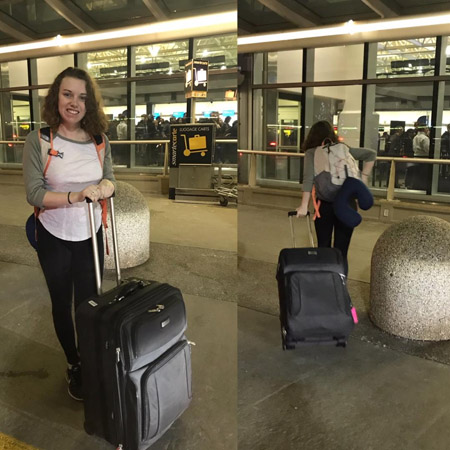 On my way to Panama.
On my way to Panama.
I was the only person in my group departing from Minneapolis, the majority of the others flew from Omaha, with some stranglers flying from Houston, Los Angeles and Haiti. My layover was in Miami, where I met up with four others who had flown from Omaha. The rest of the group, including Dr. Ibrayeva, arrived later that night.
Dr. Osiri and our driver, Moises, waited for our arrival outside of the baggage claim. We piled into a van and left for The City of Knowledge, which is where we are staying while in Panama City. The City of Knowledge is an old U.S. military base and now acts as an international community with a school and dormitories.
Each of us is sharing a room with one other student. My roommate is Katie Curtiss, a fellow business student and one of the others on my “West Coast” teakwood marketing plan team. The rooms remind me of a traditional dorm room, with a communal kitchen on our floor.
During the 45-minute drive from the airport to our accommodations, I watched out the window in awe of Panama City. The skyline was more spread out than what I’m used to seeing back home in Minneapolis. However, the buildings were taller and each one unique looking. Add beautiful palm trees, the Pacific Coast and 87-degree weather, and you have yourself the ingredients for a perfect trip.
Tips for Packing - 12/14/17
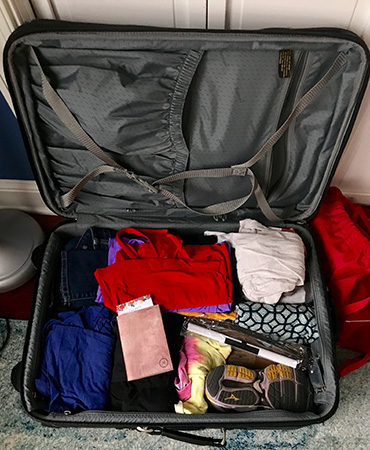 Everything is in one bag!
Everything is in one bag!
Anticipation is building because in less than two weeks I will be in Panama! I tend to be that person who has a suitcase packed the week before I am scheduled to travel. I love seeing everything laid out and ready to go, triple checking I have all I need. I brought packing early to a whole new level for this trip because I am spending two weeks of my winter break back home in Minnesota and the other two weeks in Panama. Currently, there is a 70-degree temperature difference between the two places. My bulky winter jacket laid on top of my swimsuits during the drive up.
I like to consider myself an expert packer. My family has always traveled light to avoid the costs of checking a bag. I spent three weeks in China and fit all of my stuff in a carry-on. I have found that if you plan well, you do not need as much stuff as you may think.
I will share with you my top three packing tips:
1. Make a list. Before you do anything else, grab a piece of paper and a pen and write down everything you know you need for the trip. I list the necessities and then go through my travel plans day-by-day, writing down what I will need. Nothing feels better than crossing something off your list when it gets packed. I always bring the list with me and use it to pack before I go home. It is a good way to make sure you did not forget anything.
2. Cut back on shoes. Shoes take up the most room, and often times I end up wearing the same pair or two the majority of the trip anyways. I allowed myself three pairs for Panama: my favorite sandals, a pair of tennis shoes and a pair of wedges. I always try to wear the bulkiest of the shoes I am bringing on the plane.
3. Bring extra socks. This may sound like a weird tip, but I swear that every time I travel I either lose socks or dirty them faster than I was planning. Extra socks are especially important for a trip to Panama where you will be hiking and on your feet a lot.
Fortunately, American Airlines permits a free checked bag for their customers traveling to Panama. Even so, I still tried to pack light and only bring the necessities. Dragging around an obnoxiously large suitcase is a pain, especially where you are traveling somewhere you have never been before. Now that I shared my packing tips with you and self-proclaimed myself as an expert packer, I hope there is not a future blog post in Panama about forgetting something important.
Hard at Work - 11/15/17
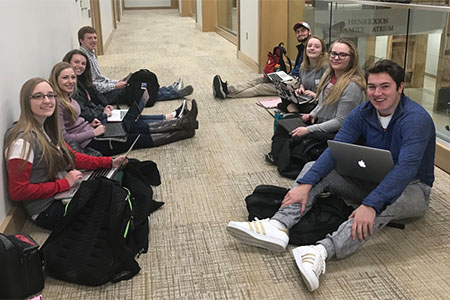 Panama's West Coast Group hard at work at their weekly meetings.
Panama's West Coast Group hard at work at their weekly meetings.
Today marks week eight of class in preparation for my trip to Panama. I will be traveling with a group of 19 other students. To prepare for our trip, we separated into two subgroups. Our semester project is to create a marketing plan for a local teakwood farmer in David, Panama. Mr. Rios, the farmer we are working with, has no prior exposure to business in the United States. He asked us to research the U.S. market for teak and present our findings in a final paper that will be shared with his company while we are in Panama.
My nine fellow team members are part of the “West Coast Group” because we are focusing on the teakwood industry of 25 states in the western part of the United States. The other students are part of the “East Coast Group” and are developing a separate marketing plan with the same requirements and for the same Panamanian farmer. Throughout the semester, we have gathered information on the teak market in the states. The research is primarily coming from reaching out to U.S. companies via both email and cold-calling who are importers of teak. The goal is to gain information on their current teak distribution methods, costs, purchasing priorities and quantities. The more answers we get about other company’s consumption, the easier it is to write a beneficial marketing plan for Mr. Rios. So far, the work is challenging, but the end goal of being able to present a useful blueprint for an actual business keeps me motivated.
With only 42 days until departure, I am busy finalizing the essential details of my trip. I have been in and out of the Health Center getting the required shots for my health clearance to enter Panama. I am double and triple checking the details of my flights with Dr. Osiri (director of International Business program) and Dr. Ibrayeva (assistant professor of practice in management) to ensure I have it right. My passport is ready for a new stamp on its pages!
Published: January 10, 2018